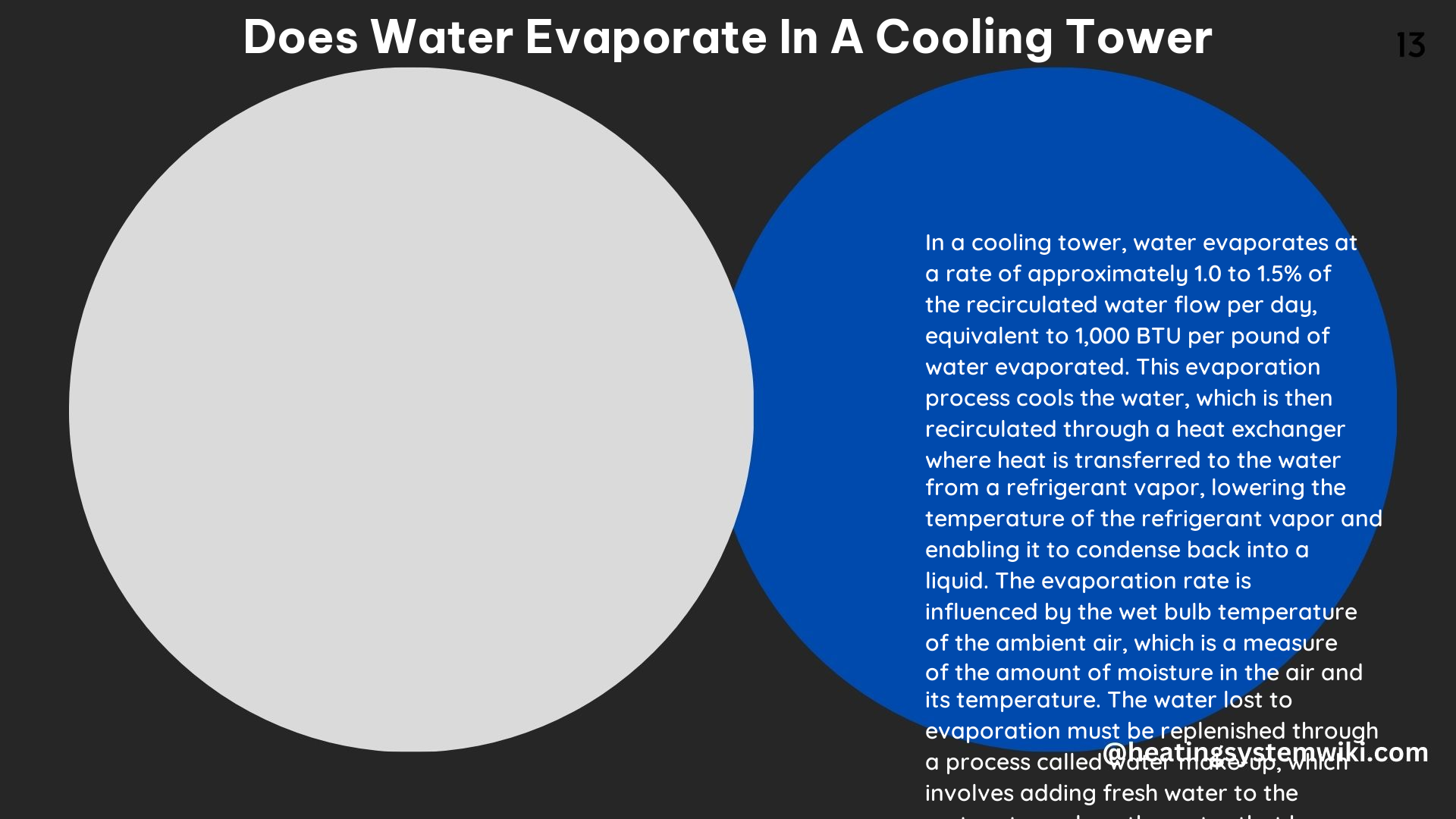Water evaporation is the primary mechanism of heat rejection in a cooling tower, where warm water is sprayed over a fill material, allowing for increased surface area and contact between the water and air. As air moves through the tower, a portion of the water evaporates, absorbing heat from the remaining water and cooling it down. This cooled water is then recirculated back to the heat exchanger to absorb more heat, creating a continuous cycle.
Technical Specification of Does Water Evaporate in a Cooling Tower
The technical specifications of a cooling tower can vary depending on the specific design and application. However, some key factors that can affect the rate of evaporation in a cooling tower include:
1. Recirculation Rate of the Cooling Tower Pumps (RR)
- The rate at which water is circulated through the cooling tower can impact the amount of heat that is transferred and the rate of evaporation.
- Typical recirculation rates for cooling towers range from 2,000 to 10,000 gallons per minute (GPM) or more, depending on the size and application of the tower.
- Higher recirculation rates can increase the rate of evaporation, but may also require more energy to operate the pumps.
2. Temperature Difference between the Water Entering and Leaving the Tower (ΔT)
- The greater the temperature difference, the more heat that can be rejected and the higher the rate of evaporation.
- Typical temperature differences in cooling towers range from 5°F to 15°F, with higher differences resulting in higher evaporation rates.
- The temperature difference is influenced by factors such as the ambient air temperature, humidity, and the efficiency of the heat transfer process.
3. Concentration Ratio (C)
- The concentration ratio of minerals in the tower water versus the fresh water make-up can impact the rate of evaporation and the amount of bleed-off that is required to prevent mineral buildup.
- Typical concentration ratios range from 1.5 to 4, with higher ratios resulting in higher evaporation rates but also increased mineral buildup.
- Proper water treatment and bleed-off management are essential to maintain the desired concentration ratio and prevent scale formation.
4. Airflow Rate
- The rate at which air is moved through the cooling tower can impact the amount of heat that is transferred and the rate of evaporation.
- Typical airflow rates for cooling towers range from 10,000 to 100,000 cubic feet per minute (CFM) or more, depending on the size and design of the tower.
- Higher airflow rates can increase the rate of evaporation, but may also require more energy to operate the fans.
5. Fill Material
- The type and configuration of the fill material can impact the surface area available for heat transfer and the rate of evaporation.
- Common fill materials include splash-type fills, film-type fills, and hybrid fills, each with their own advantages and disadvantages in terms of heat transfer, pressure drop, and maintenance requirements.
- The fill material should be selected based on the specific application and design requirements of the cooling tower.
6. Water Quality
- The quality of the water used in the cooling tower can impact the rate of evaporation and the amount of mineral buildup that occurs.
- Factors such as the pH, hardness, and dissolved solids content of the water can affect the rate of evaporation and the need for water treatment.
- Proper water treatment, including chemical treatment and filtration, is essential to maintain the desired water quality and prevent scale formation and fouling.
Does Water Evaporate in a Cooling Tower DIY

While it is possible to build a DIY cooling tower for small-scale applications, it’s important to note that proper design and construction are critical to ensure efficient and safe operation. Factors to consider when building a DIY cooling tower include:
-
Materials: The materials used to build the cooling tower should be able to withstand the corrosive effects of water and air, as well as the weight of the water. Common materials used in DIY cooling towers include PVC, galvanized steel, and wood.
-
Design: The design of the cooling tower should allow for adequate airflow and heat transfer, as well as proper water distribution and drainage. Key design considerations include the size and shape of the tower, the configuration of the fill material, and the placement of the water distribution system and air intake.
-
Maintenance: Regular maintenance, including cleaning and water treatment, is essential to ensure the efficient and safe operation of the cooling tower. This may include tasks such as removing debris from the fill material, cleaning the water distribution system, and monitoring water quality.
-
Safety: Proper safety measures, including guards and barriers, should be in place to prevent accidents and injuries. This is particularly important for DIY cooling towers, which may not have the same level of safety features as commercial units.
Overall, while a DIY cooling tower may be feasible for small-scale applications, it’s important to carefully consider the design, materials, and maintenance requirements to ensure safe and efficient operation. Consulting with a professional engineer or cooling tower manufacturer can also be helpful in ensuring the proper design and construction of a DIY cooling tower.
